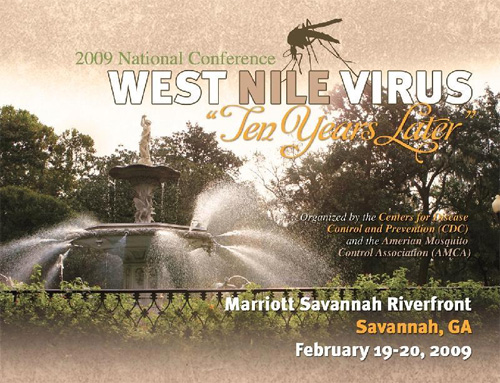
West Nile Virus National Conference – 2009
Co-sponsors:
Centers for Disease Control and Prevention
American Mosquito Control Association
Save the Date!
Date: Feb 19-20, 2009
Location: Savannah, Georgia
Hotel: Marriott Savannah Riverfront
In less than 10 years, West Nile Virus spread from New York City west to the Pacific Ocean, north to central Canada, and south through the Caribbean Islands and Central America to Argentina. During this time, it became pervasive in the environment and produced a significant public health and economic impact. The virus is found in over 60 mosquito species and 300 bird species in the U.S alone. Since 1999, WNV caused countless human infections, thousands of cases of serious disease resulting in persistent neurological deficits, paralysis and death, and caused the blood industry to screen every donation for presence of the virus. The impact of WNV has been accompanied by a rapid increase in knowledge about the virus, from its molecular biology to its transmission ecology.
2008 marks the 10th year of West Nile virus presence in the Western Hemisphere, and follows several years of expanding arboviral zoonosis activity around the globe. Chikungunya, Japanese Encephalitis, Rift Valley Fever, Yellow Fever and Zika viruses have made public health headlines from Kenya to India, and Micronesia to Italy. The increasing incidence of these diseases has been associated with virus evolution, land use practices, travel, and climate change.
The Centers for Disease Control and Prevention and the American Mosquito Control Association will co-sponsor a national/international meeting in the spring of 2009 to discuss the public health significance of WNV and other zoonotic arboviruses, scientific advances, and preparedness for the threats these agents pose.
Format: Two days of oral presentations by international experts and poster sessions on topics related to West Nile and other zoonotic arbovirus:
- Epidemiology and Surveillance
- Clinical outcomes of WNV infection
- Virology and Diagnosis
- Transmission Ecology
- Prevention and Control
- Global arbovirus threats
More information coming soon.

